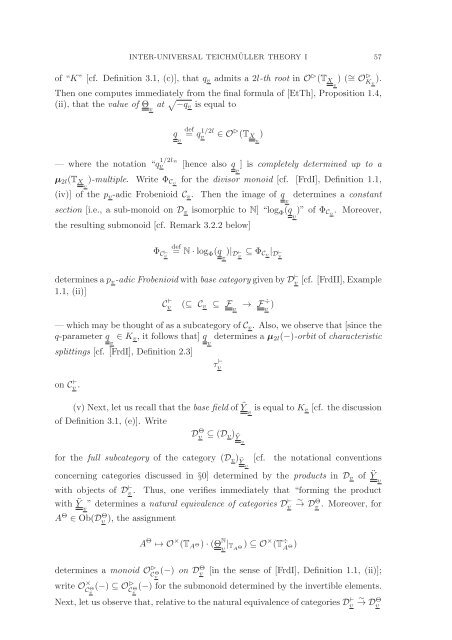Inter-universal Teichmuller Theory I: Construction of Hodge Theaters
Inter-universal Teichmuller Theory I: Construction of Hodge Theaters
Inter-universal Teichmuller Theory I: Construction of Hodge Theaters
Create successful ePaper yourself
Turn your PDF publications into a flip-book with our unique Google optimized e-Paper software.
INTER-UNIVERSAL TEICHMÜLLER THEORY I 57<br />
<strong>of</strong> “K” [cf. Definition 3.1, (c)], that q v admits a 2l-th root in O ⊲ (T Xv )( ∼ = OK ⊲ v<br />
).<br />
Then one computes immediately from the final formula <strong>of</strong> [EtTh], Proposition 1.4,<br />
(ii), that the value <strong>of</strong> Θ v<br />
at √ −q v is equal to<br />
q<br />
v<br />
def<br />
= q 1/2l<br />
v ∈O ⊲ (T Xv )<br />
— where the notation “qv<br />
1/2l ” [hence also q ]iscompletely determined up to a<br />
v<br />
μ 2l (T Xv )-multiple. Write Φ Cv for the divisor monoid [cf. [FrdI], Definition 1.1,<br />
(iv)] <strong>of</strong> the p v -adic Frobenioid C v . Then the image <strong>of</strong> q determines a constant<br />
v<br />
section [i.e., a sub-monoid on D v isomorphic to N] “log Φ (q )” <strong>of</strong> Φ Cv . Moreover,<br />
v<br />
the resulting submonoid [cf. Remark 3.2.2 below]<br />
Φ C ⊢ v<br />
def<br />
= N · log Φ (q<br />
v<br />
)| D ⊢ v<br />
⊆ Φ Cv | D ⊢ v<br />
determines a p v -adic Frobenioid with base category given by D ⊢ v [cf. [FrdII], Example<br />
1.1, (ii)]<br />
C ⊢ v (⊆ C v ⊆ F v<br />
→ F ÷ v )<br />
— which may be thought <strong>of</strong> as a subcategory <strong>of</strong> C v . Also, we observe that [since the<br />
q-parameter q ∈ K v , it follows that] q determines a μ 2l (−)-orbit <strong>of</strong> characteristic<br />
v v<br />
splittings [cf. [FrdI], Definition 2.3]<br />
on C ⊢ v .<br />
τ ⊢ v<br />
(v) Next, let us recall that the base field <strong>of</strong> Ÿ is equal to K v<br />
v [cf. the discussion<br />
<strong>of</strong> Definition 3.1, (e)]. Write<br />
D Θ v<br />
⊆ (D v )Ÿ<br />
v<br />
for the full subcategory <strong>of</strong> the category (D v )Ÿ<br />
v<br />
[cf. the notational conventions<br />
concerning categories discussed in §0] determined by the products in D v <strong>of</strong> Ÿ v<br />
with objects <strong>of</strong> Dv ⊢ . Thus, one verifies immediately that “forming the product<br />
with Ÿ ” determines a natural equivalence <strong>of</strong> categories v D⊢ ∼<br />
v →Dv Θ . Moreover, for<br />
A Θ ∈ Ob(Dv Θ ), the assignment<br />
A Θ ↦→O × (T A Θ) · (Θ N v | T A Θ<br />
) ⊆O × (T ÷ A Θ )<br />
determines a monoid O ⊲ (−) on D Θ Cv<br />
Θ v [in the sense <strong>of</strong> [FrdI], Definition 1.1, (ii)];<br />
write O × (−) ⊆O ⊲ (−) for the submonoid determined by the invertible elements.<br />
Cv<br />
Θ Cv<br />
Θ<br />
Next, let us observe that, relative to the natural equivalence <strong>of</strong> categories D ⊢ v<br />
∼<br />
→D Θ v
















